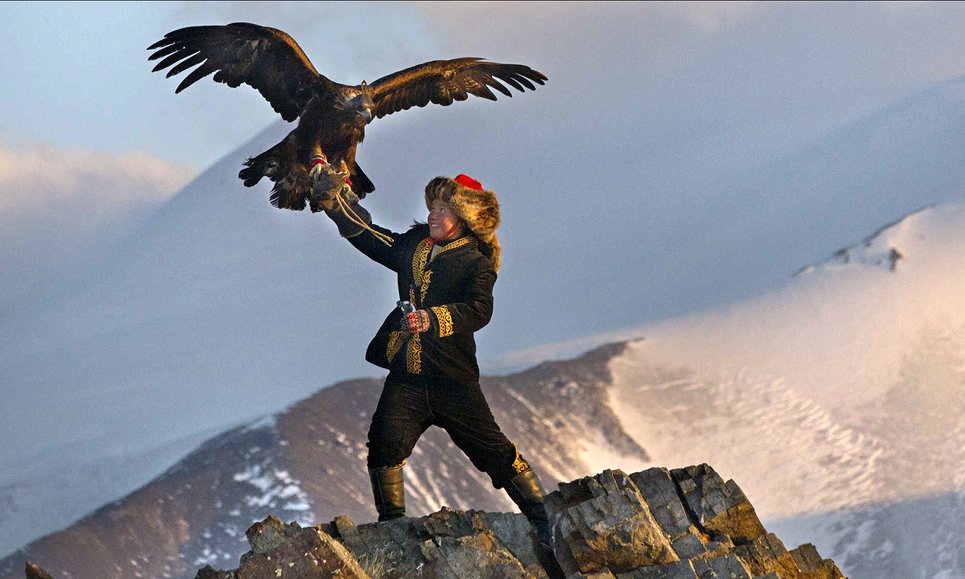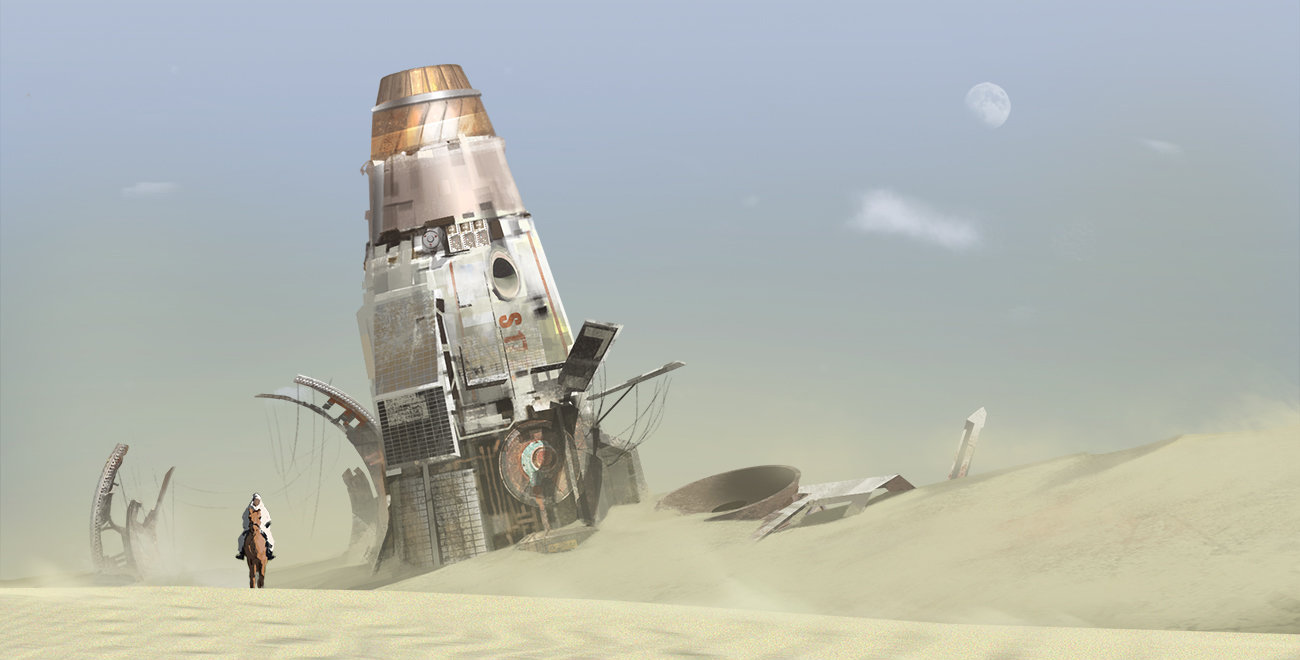
Otto Bell had never made a feature film. But when he saw this photo, he flew to Mongolia — and made a movie about a girl's struggle to capture and tame a golden eagle. It's called The Eagle Huntress, and now it may get an Oscar.
Otto Bell was surfing the web at work when he saw this photo. It amazed him: a rosy-cheeked Mongolian girl, perched on a mountain ridge, smiling with delight at a ferocious golden eagle flapping on her arm. Look at her face!
The scene was a world away from the office cubicle in New York where Bell was sitting. The shots were taken in the Altai mountains, "the most remote part of the least-populated country in the world". He had no financing and had only ever made short, commercially funded documentaries. But he was so moved that soon he gathered up a small team and took a flight to Mongolia to track down the girl: a 13-year-old named Aisholpan.
When they finally found her nomadic family, Bell was nervous they might not want to be filmed. Instead her father Nurgaiv made an extraordinary offer. "This afternoon we are going down the mountain to steal an eagle for Aisholpan. Do you want to film that?"
Aisholpan had her eye on a fledgling female. Female eagles are larger, so preferred for hunting. For days, Aisholpan had been watching this one through her father's old broken binoculars. It was the perfect age: able to survive without her mother, but young enough to be trained.
Capturing Aisholpan's climb down a sheer cliff to an eagle's nest, with only a rope tied round her waist, posed problems for them all. For a start, the cameraman was afraid of heights so could only film from solid ground below! The photographer wasn't well-placed to step in, since he'd never shot moving images. So Bell had to get creative. He strapped a GoPro inside Aisholpan's cardigan and climbed with the photographer to a ledge opposite the nest to capture another angle.
It's a heart-stopping scene: a young girl with plaits jauntily tied with pink ribbons makes a terrifying descent while an angry mother eagle circles menacingly overhead. Some movie reviewers assume the scene is a re-creation. But it's the real thing.
I have got to see this movie! I haven't yet. This picture makes me happy. It makes me, too, want to rush off to the Altai mountains near the borders of Mongolia, China, Russia and Kazakhstan. Lake Kucherla looks amazing. But I have to grade finals.
My writeup above is paraphrased from this review:
(I wound up seeing this movie and my aunt on January 3rd, and it met my
high expectations! Great scenery, a simple and unadorned but thrilling
story, and lots of interesting views of life near the Altai mountains.
One interesting tidbit at the start: golden eagles raised for hunting are
let free after seven years. I'm not sure how well that works out.)
December 2, 2016


That's what Governor Jerry Brown just said to 24,000 climate scientists in San Francisco, to thunderous applause. And:
And to Rick Perry of Texas, newly appointed to lead a department whose name he forgot when listing 3 departments he'd abolish if he were president — oh yeah, the Department of Energy:
Brown is at the annual meeting of the American Geophysical Union. I went there once — it's huge. They usually meet in San Francisco because it has one of the few conference centers big enough to hold 24,000 people.
The move to save climate data continues. Right now the main thing we could use is 3 terabytes of storage space; to get that from Google seems to cost $100/month, since they'll give you 1 terabyte for $10/month and then 10 terabytes for $100/month.
Jan Galkowski, a professional statistician and member of the Azimuth Project, is spending Christmas break downloading data using WebDrive. He could use 3 terabytes of space.
First we're downloading stuff. In the longer term we will try to make this stuff publicly available. And we will try to coordinate with the Climate Mirror project, here:
Tomorrow I will talk to someone involved in this project and the head of the Society of American Archivists, since they know a lot about archiving data. I would like to find more ways for ordinary folks to help, but right now it's a confusing scramble to organize things.
You can see Jerry Brown's speech here:
I like the look of this thing! It's a metal-organic framework — a compound made of metal ions connected by organic stuff. The picture here is just part of a structure that keeps repeating in all directions.
The blue tetrahedra are made of an oxygen atom surrounded by 4 atoms of zinc. They're connected by a kind of latticework made of an organic molecule called 1,4-benzodicarboxylic acid.
The whole thing is called 'Metal-Organic Framework 5' or 'MOF5' for short. There are lots of other kinds.
But what about the huge yellow ball?
That's not a real thing. It's empty space where you can put something — like a molecule of hydrogen!
And indeed, metal-organic frameworks are used for storing hydrogen - you can actually pack more hydrogen into a MOF than you can easily squeeze into an empty tank! They can also be used as catalysts. So they're not only beautiful, they're practical.
For a bigger view of MOF5, go here:
For more about metal-organic frameworks, go here:
Also check out my new
collection of chemistry posts on G+.
December 29, 2016
It's better to do something imperfect that helps than not help at all.
We so easily forget that. Here's a great story to help us remember:
the Hair Dryer Incident, as told by psychatrist Scott Alexander:
The Hair Dryer Incident was probably the biggest dispute I've seen in the mental hospital where I work. Most of the time all the psychiatrists get along and have pretty much the same opinion about important things, but people were at each other's throats about the Hair Dryer Incident.This is from:Basically, this one obsessive compulsive woman would drive to work every morning and worry she had left the hair dryer on and it was going to burn down her house. So she'd drive back home to check that the hair dryer was off, then drive back to work, then worry that maybe she hadn't really checked well enough, then drive back, and so on ten or twenty times a day.
It's a pretty typical case of obsessive-compulsive disorder, but it was really interfering with her life. She worked some high-powered job — I think a lawyer — and she was constantly late to everything because of this driving back and forth, to the point where her career was in a downspin and she thought she would have to quit and go on disability. She wasn't able to go out with friends, she wasn.t even able to go to restaurants because she would keep fretting she left the hair dryer on at home and have to rush back. She'd seen countless psychiatrists, psychologists, and counselors, she'd done all sorts of therapy, she'd taken every medication in the book, and none of them had helped.
So she came to my hospital and was seen by a colleague of mine, who told her "Hey, have you thought about just bringing the hair dryer with you?"
And it worked.
She would be driving to work in the morning, and she'd start worrying she'd left the hair dryer on and it was going to burn down her house, and so she'd look at the seat next to her, and there would be the hair dryer, right there. And she only had the one hair dryer, which was now accounted for. So she would let out a sigh of relief and keep driving to work.
And approximately half the psychiatrists at my hospital thought this was absolutely scandalous, and This Is Not How One Treats Obsessive Compulsive Disorder, and what if it got out to the broader psychiatric community that instead of giving all of these high-tech medications and sophisticated therapies we were just telling people to put their hair dryers on the front seat of their car?
I, on the other hand, thought it was the best fricking story I had ever heard and the guy deserved a medal. Here's someone who was totally untreatable by the normal methods, with a debilitating condition, and a drop-dead simple intervention that nobody else had thought of gave her her life back. If one day I open up my own psychiatric practice, I am half-seriously considering using a picture of a hair dryer as the logo, just to let everyone know where I stand on this issue.
Miyamoto Musashi is quoted as saying:
The primary thing when you take a sword in your hands is your intention to cut the enemy, whatever the means. Whenever you parry, hit, spring, strike or touch the enemy's cutting sword, you must cut the enemy in the same movement. It is essential to attain this. If you think only of hitting, springing, striking or touching the enemy, you will not be able actually to cut him.Likewise, the primary thing in psychiatry is to help the patient, whatever the means. Someone can concern-troll that the hair dryer technique leaves something to be desired in that it might have prevented the patient from seeking a more thorough cure that would prevent her from having to bring the hair dryer with her. But compared to the alternative of "nothing else works" it seems clearly superior.
Thanks to Richard Mlynarik for leading me to this, indirectly. He actually pointed me to an interesting article about psychology and network theory:
The idea is that some mental disorders, instead of having a single "root cause", are a network of symptoms that reinforce each. Some, not all!
That article led me to this tale here
December 30, 2016
Gil Wizen, who photographed this monster, writes:
Encountering this species was one of my highlights for the year. I know Macrodontia cervicornis very well from museum insect collections. It is one of the most impressive beetle species in the world, both in size and structure. But I never imagined I would be seeing a live one in the wild! Well let me tell you, it is hard to get over the initial impression. The male beetle that I found was not the biggest specimen, but the way it moved around still made it appear like nothing short of a monster. This species is very defensive, and getting close for the wide angle macro shot was a bit risky. The beetle responds to any approaching object with a swift biting action, and those jaws are powerful enough to cut through thick wooden branches, not to mention fingers!
Check out his favorite photos of the year: